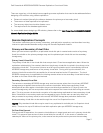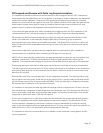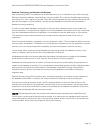Dell PowerVault MD3600f/MD3620f Remote Replication Functional Guide
Page 2
Dell MD36X0f Remote Replication (RR) Overview
Remote Replication (RR) is the MD36X0f array feature that provides the ability to remotely replicate data
from one MD36X0f storage array to another. RR is an optional premium feature that requires activation,
configuration, and in normal replication operations, administration and control; the latter two tasks do
not require lots of time and manpower resources, and they can be automated through scripting.
Key Benefits of PowerVault MD Remote Replication (RR)
• SAN Based Replication - Data replication between the primary virtual disk and the secondary virtual
disk is managed by the MD36X0f storage arrays and is transparent to host machines and applications.
• Replication modes - RR supports
synchronous
,
asynchronous
, and
asynchronous with write
order
consistency
replication modes. These modes help administrators choose the replication method that
best meets protection, distance or performance requirements.
• Dynamic replication mode switching without suspending the replication – Users can switch
between replication modes at any time. This enables administrators to accommodate changing
application and bandwidth requirements without sacrificing protection.
• Ease of use - IT administrators can enable replication through the Modular Disk Management System
(MDSM) GUI or MDSM CLI. Once enabled, RR functions can be managed using the MDSM GUI, the
CLI, or MDSM vCenter plug-in. These tools are available free of charge.
• Multiple replication relationships - A replication connection is not limited to a single primary RR
system and a single remote RR system. In general, each MD36X0f with the optional RR premium
feature installed and activated may be either a primary system or a secondary system, or both. Up to
16 replication relationships are supported.
• Suspend and resume - RR provides the ability to suspend replication by explicitly using the Suspend
command, and under certain circumstances to automatically suspend replication (consistency group
suspension, asynchronous replication when link bandwidth exceeded).
• Role reversal/fail over – RR allows reversing the roles of primary and secondary virtual disks to
recover from a disaster.
• Read-only replica access (includes Snapshot creation) - RR enables the remote data to be utilized
prior to a disaster without sacrificing protection of the primary site data.
Remote Replication Functional Overview
Once activated, RR requires that you specify the virtual disks that you wish to replicate, configure the
replication by selecting the remote MD36X0f you wish to have the secondary replicated copies on, and
then to select and create the secondary virtual disk storage on the remote MD36X0f. Initially, RR will
begin operations by copying the entire contents of the virtual disks that you wish to replicate from the
primary site’s MD36X0f to the remote site’s MD36X0f. Once this initial copy operation is complete, active
replication begins. For every subsequent write to the primary MD36X0f storage array, there is a
corresponding write sent to the remote site MD36X0f and then written to the corresponding remote
virtual disk.
RR can be activated and configured at any time; additional virtual disk replication can be configured
when necessary.

















